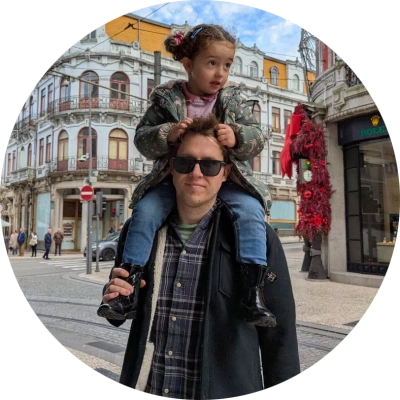9 Highly Effective Language Learning Resources and Techniques
Language learning experts reveal practical techniques that combine traditional methods with innovative approaches for faster fluency. Research shows that consistent exposure to native speech paired with interactive practice yields the most effective results. These nine proven strategies offer clear pathways to language mastery without overwhelming complexity.
Switch to Enjoyable Media When Motivation Wanes
When learning a new language, I've found that switching to enjoyable media like music and television shows has been particularly effective, especially during times when my motivation begins to wane. This approach keeps me engaged with the language in a low-pressure environment while still exposing me to natural speech patterns and cultural context. I recommend others incorporate this technique when they feel fatigued with traditional study methods, allowing themselves to simply enjoy content in their target language without the pressure of formal learning. The key is finding media that genuinely interests you, making language acquisition feel less like work and more like entertainment.

Flashcards Plus Real Life Conversations Work
My favorite language learning technique is a mix of the old-fashioned and the wildly immersive: flashcards and real life. Flashcards might seem like a relic in the age of slick language apps, but they work because they're simple and portable. You can sneak in a few words while waiting for the kettle to boil or while a child is building a tower beside you. They make language learning bite-sized, and that's key when your life doesn't revolve around a rigid class schedule. But the trick isn't just memorizing words; it's making those words live somewhere real.
That's where real-life practice comes in. Language doesn't stick until it's been used awkwardly in a bakery or shouted across a market while trying to buy the right kind of bread. The moment you have to use what you've learned, the brain suddenly decides it's worth remembering. You can't fake that urgency in a textbook. It's humbling, funny, and a little terrifying at first, but those moments are where confidence grows. The grammar books give you scaffolding, but it's the conversations with taxi drivers, baristas, or new friends that build the house.
For families who worldschool or travel as part of their education, this combination becomes even more powerful. You learn in bursts; a few flashcards in the morning, then testing them out in the wild later that day. Children especially thrive on that feedback loop because they see the payoff immediately: "I said it right, they understood me!" It's language as a living game rather than an abstract subject.
If I were to recommend this to others, I'd say start small but stay curious. Use flashcards to build a base, then give yourself permission to stumble through conversations without expecting perfection. The best lessons often come from the slightly embarrassing ones. And if you ever get the chance to learn while living in the language's home country, take it. No app or teacher can replicate the magic of realizing you just ordered lunch entirely in another tongue; and it actually arrived the way you hoped.

Context-Driven Apps With Consistent Daily Practice
As a speech pathologist, I have found immersive, context-driven language learning to be the most effective approach for both clinical practice and personal growth. One particularly valuable resource has been the use of interactive language apps that combine listening, speaking, and comprehension exercises with real-life dialogues. Research shows that adults retain new vocabulary more effectively when they are exposed to language in meaningful contexts rather than rote memorization, with studies indicating up to a 60 percent improvement in retention when contextual learning is applied. Additionally, incorporating speech recognition technology allows learners to receive immediate feedback on pronunciation and fluency, which is critical for building confidence and accuracy in spoken language. I recommend that learners use these tools consistently, aiming for short, focused daily practice sessions rather than infrequent long sessions, as cognitive science demonstrates that distributed practice strengthens neural pathways more effectively than massed practice. Beyond technology, I encourage pairing app-based learning with social interaction, such as conversation groups or online exchanges, because engaging in authentic dialogue enhances pragmatic language skills and cultural understanding. Overall, combining immersive technology with real-world practice creates a dynamic and sustainable language learning experience that mirrors natural acquisition processes and supports long-term proficiency.

YouTube With Dual Subtitles Creates Precision
Our favourite resource is YouTube + dual subtitles with Language Reactor, paired with a simple contrast log and Anki cloze cards. It beats generic "immersive" advice because parallel input gives immediate, line-by-line contrast: you see exactly how tense, particles, and register shift between L1 and L2. With thousands of real clips across domains (news, interviews, how-tos), you're training on living language—not textbookese. It scales to any level, any language, and it's brutally honest about what you don't yet hear.
Why it's been particularly helpful:
Precision noticing: Dual subs surface grammar and collocations you'd miss in raw listening.
Transfer to output: A quick microscale rewrite of a few lines reveals gaps in word choice and word order.
Retention: Turning the exact tricky chunk into a cloze card locks it in; no bloated decks.
How we recommend using it:
Pick a 2-4 minute clip with accurate subs. Watch in L2, then toggle L1 only to confirm meaning.
Shadow 10-20 second slices; focus on rhythm and chunking, not speed.
Rewrite 3-5 key lines in L2, then compare to the native lines.
Log three takeaways in a 3-column sheet: mine / native / rule.
Make 3-5 cloze cards from those rules; review tomorrow, in 3 days, and a week later.
That loop takes ~30-40 minutes, delivers measurable gains in comprehension, prosody, and recall, and doesn't depend on a single textbook or teacher. Tools are optional—the parallel + contrast + cloze pattern is what moves the needle.

Learn Trade Language Through Job Site Immersion
I don't use abstract language learning resources. My favorite technique is hands-on and born out of necessity: Total Immersion into the Language of the Trade.
When I needed to communicate structural concepts effectively with my Spanish-speaking crews, abstract courses and apps were useless. Language is structural, and I needed to learn the specific, hands-on vocabulary that ensures safety and quality control.
The technique that has been particularly helpful is simple: I learned the name for every single tool and structural component on the job site in the trade language first. I didn't start with greetings; I started with "flashing," "rafter," "tie-off point," and "decking rot." I forced myself to learn the physical language of the work.
This hands-on immersion worked because it provided immediate structural utility. My crews corrected my hands-on mistakes in real-time, and we built trust because they saw my commitment was rooted in their safety and the integrity of the work.
I would recommend others use it by focusing their learning entirely on the structural facts of their business. Stop learning how to order a beer and start learning the specific, hands-on names for the parts, the processes, and the failures in your trade. The best way to learn any language is to be a person who is committed to a simple, hands-on solution that makes communication a matter of structural necessity.
Visual Context Through Interactive Digital Panels
Interactive immersion through visual context has proven the most effective language learning technique, especially when used with PCS Interactive Panels. Instead of memorizing vocabulary in isolation, students connect words to images, gestures, and real-time dialogue scenarios displayed on the panel. For instance, during a Spanish lesson, learners can tap on objects in a digital kitchen scene to hear pronunciation, see sentence usage, and respond to prompts. This multisensory approach strengthens memory retention by linking meaning to experience rather than repetition. I recommend educators use short, thematic modules—like "at the market" or "in the classroom"—to maintain focus while gradually expanding context. The method turns language learning into a living conversation, allowing comprehension to develop naturally through interaction, not translation.

Surround Yourself With Native Speaker Audio
Immersive listening has been the most effective technique. Instead of traditional study sessions, surrounding myself with the target language through podcasts, interviews, and short documentaries builds an intuitive grasp of rhythm and phrasing. Hearing native speakers in natural contexts reveals nuances that textbooks rarely capture, such as tone shifts, filler words, and regional expressions. Pairing this with light transcription—writing down key phrases while listening—deepens retention and connects sound to structure. For anyone starting out, consistency matters more than duration. Fifteen minutes of focused, active listening each day will sharpen comprehension far faster than infrequent study marathons. Over time, patterns emerge naturally, and confidence grows without the pressure of formal drills.

Daily Audio Shadowing Builds Accent Confidence
My best results came from "shadowing" short audio clips daily instead of doing long study sessions. I used simple native-speaker sentences on YouTube and repeated them out loud while walking, copying pace and tone like karaoke with no screen. It trained my mouth and ear at the same time and killed the fear of sounding wrong. I kept clips to under 30 seconds and cycled the same one for a week. After a month people told me my accent jumped more than my vocab, which was the real bottleneck. For others I'd say pick tiny audio, repeat daily, and track minutes not lessons.

Natural Conversations With Native Speakers Weekly
My favourite language learning technique is open, natural conversation with native speakers. For the past two years, I've been using a platform that pairs you with a volunteer — a regular native speaker — for a one-hour online session each week. We just talk about anything: work, travel, news, and everyday life. It's not a formal lesson, so my grammar might not improve dramatically, but my speaking confidence has grown enormously.
After a few months of these sessions, I realised I no longer felt nervous before calls with international clients. I then suggested this approach to our business development manager, and she noticed the same shift — she stopped hesitating and started enjoying conversations with clients. This year, we decided to involve all our project managers at Tinkogroup, and I can already see how this simple practice helps the team speak more confidently, naturally, and without fear of making mistakes.



